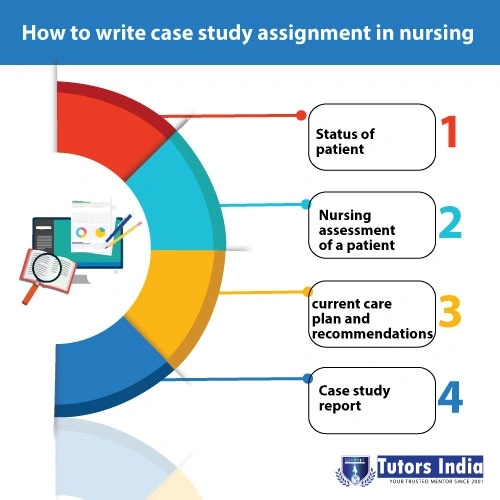How to write a case study assignment in nursing
In Brief
A nursing case study is an in-depth investigation and accompanying explanation of a patient or a group of patients suffering from a specific illness or disorder to promote a thorough understanding of their situation. It may also provide a thorough examination of a single individual or population as a basis for medical and healthcare phenomena. Your case study should conclude with a thorough account of an actual or hypothetical problem, occurrence, or operation at the end of writing.

Introduction and Categories of a nursing case study
- Status of the patient: Discusses the patient and the study’s intent. The following data is included in it:
- Demographics
- Medical history
- Diagnosis and treatment
2. Nursing assessment of a patient: Describes the patient’s concern in medical terminology and the reason for having a particular diagnosis, such as hyperacidity influencing the patient’s digestion. It comprises the following items:
- Vital signs and results of tests
- Findings by the nurse, such as emotional state and range of motion
SEE ALSO: Focus on Nursing research priorities based on CINAHL
- Current care plan and recommendations: Nursing care plans and their priorities are identified. The goal is to illustrate how a nursing care strategy will improve a patient’s quality of life, the substantive improvements it aims to make, and how to put it into action. It also shows the individual in charge of implementing the treatment plan and concrete targets for tracking and determining its progress.
This portion of a case study report can be divided into the following subsections:
- Nursing care plan details, including priorities and interventions
- A summary of the proposed treatment package
- Suggestions for any improvements to the proposed treatment plan

How to write a case study assignment in nursing
Start your article with a short introduction that provides readers with a good picture of how you are looking for a solution. Clearly state the issue you’re trying to solve in your research. You can also provide background material on the issue, including facts and statistics from credible sources. You can use diagrams, charts, images, audio recordings, photographs, and everything else to explain the case.
- It would help if you wrote your assignment in this case study format for clarification of detail, easy reading, and a smooth flow:
- Title page: The full title of your paper is included here.
- Abstract: An abstract may be written in a story or formal format. A narrative is a simplified version of an entire document that describes a logical, fluid story without using headings. Subheadings in a structured overview aid in an internet search. A formal abstract has subsections for introduction, case presentation, management, result, and discussion.
- Introduction: Expresses a strong understanding of why the situation you’re presenting is so interesting.
- Case presentation: Raw details detailing the patient’s complaint, critical facts about the history and a summary of the clinical test outcomes. It is optional to include a shortlist of possible illnesses or conditions underlying the symptoms.
- Management and outcome: Describe the treatment procedure, current treatment, and the result. It is essential to determine the duration and pace of patient treatment.
- Discussion: Identifies the problems that the examination poses.
- Acknowledgements: I’d like to share my gratitude to those who assisted in preparing the case study in a few words. It is not customary to express gratitude to the patient. Thanking those who were not personally involved in preparing the nursing case study task, such as peers and professors, is often unfair.
- References: Identify the writers, a list of references is provided. For a good reason, don’t go over 15 sources. Avoid using personal correspondence because readers will not be able to access the content, and avoid using textbooks because many people already have access to the material.
- Legends: Tables, images, numbers, and other non-text resources are adequately described. At the end of your book, have a section of charts, photos, and statistics.
- Permissions: If you borrow their charts, images, statistics, or significantly quote their published work, you must show a letter of approval from the content publisher. Require informed consent from patients in all photographs that may be used to identify them.
SEE ALSO: Instructions to Write Law Assignments
Conclusion:
Your recommendations should be the final topic of conversation. What other steps do you prescribe to increase the patient’s odds of survival based on the patient’s medical condition, diagnosis, prognosis, and nursing care plan? It does not have to be a discouraging job to publish a well-written nursing case study article writing sample. It’s satisfying, and it’s also an excellent way to test patients when out in the field. Remember that your professor would not only rate you on the accuracy of your paper’s material. If you find yourself wasting a lot of time formatting the document, try using formatting tools to ensure consistency and avoid losing points on a well-written paper due to minor formatting errors.
References:
- Adejumo O. & Brysiewicz P. (1998) Coping strategies adopted by baccalaureate nursing students in a problem-based learning program. Education for Health 11, 349–356.
- Aspinwall L.G. & Taylor S.E. (1992) Modeling cognitive adaptation: a longitudinal investigation of the impact of individual differences and coping on college adjustment and performance. Journal of Personality and Social Psychology 63, 689–1003.
- Beck D.L. & Srivastava R. (1991) Perceived level and sources of stress in baccalaureate nursing students. Journal of Nursing Education 30, 127–133.
- Bolger N. (1990) Coping as a personality process: a prospective study. Journal of Personality and Social Psychology 59, 525–537

 Previous Post
Previous Post Next Post
Next Post